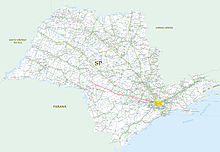Rodovia Castelo Branco
 | |
|---|---|
 President Castelo Branco Tollway (in red) | |
| Native name | Castelo Branco Error {{native name checker}}: parameter value is malformed (help) |
| Namesake | Humberto de Alencar Castelo Branco |
| Type | From Osasco to Sorocaba six-lane highway, from Sorocaba to Espírito Santo do Turvo four-lane highway. |
| Length | 315 km (196 mi) |
| Location | Passes through Osasco, Barueri, Carapicuíba, Santana de Parnaíba, Itapevi, São Roque, Araçariguama, Itu, Sorocaba, Porto Feliz, Iperó, Tatuí, Boituva, Cesário Lange, Bofete, Conchas, Botucatu, Itatinga, Avaré, Cerqueira César, Águas de Santa Bárbara, Espírito Santo do Turvo |
| East end | Osasco Next to São Paulo |
| Major junctions | SP 075 (Rodovia Santos Dumont), km |
| West end | Santa Cruz do Rio Pardo |
| Construction | |
| Inauguration | 1967-1981 |
Rodovia Presidente Castelo Branco (SP-280) is a tollway in the state of São Paulo, Brazil. It was first opened on November 10, 1968, by, then, the Governor of the state of São Paulo, Abreu Sodré. The tollway name was given in memory of former military leader Field Marshal Humberto de Alencar Castelo Branco, who served as President of Brazil during the military dictatorship.
Running westbound from the city of São Paulo and finishing in Espírito Santo do Turvo, while heading towards the state of Mato Grosso do Sul, near the northern border of the southern state of Paraná, 'Rodovia Castelo Branco, as it is popularly known, is about 315 km (196 mi) long, and one of Brazil's safest tollways. The tollway passes by several cities, including: Barueri, Santana de Parnaíba, São Roque, Sorocaba, Tatuí, Avaré and Águas de Santa Bárbara. Near Barueri and due to the large population of São Paulo, Rodovia Castelo Branco is one of the busiest and widest of Brazil's tollways.
Initially known as Rodovia do Oeste (Western Expressway), it was built in three phases. The first phase was during 1963 to 1968 (from the city of São Paulo to the city of Torre de Pedra, extending 170 km west). The second phase was during 1971, reaching the city limits of São Manuel and Avaré (another 58 km). The final and third phase, for 74 km, ended at highway SP-225, near the city of Santa Cruz do Rio Pardo. Travelers going to Ourinhos and the Northwest part of the State of Paraná often follow the Castelo Branco (SP-225) route.
The tollway is managed and maintained by a state concession to three private companies: SPVias, Rodovias das Colinas and ViaOeste.
See also
External links
- Oficial Brazilian governmental road maps for the State of São Paulo (in Portuguese)
- Road finder viewer for the state of São Paulo
